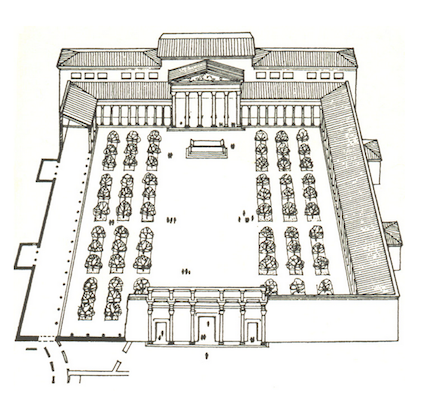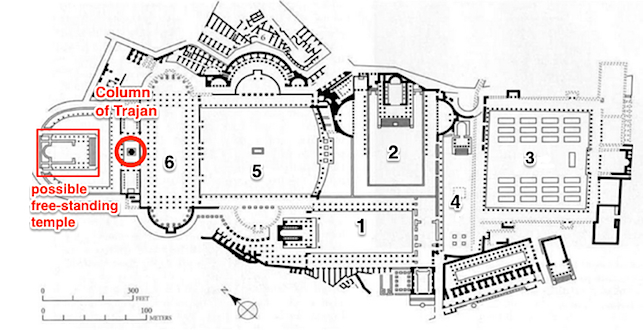For centuries, the Roman Forum (Forum Romanum) was the civic, juridical, and social heart of the ancient city of Rome, a place where civic buildings, sacred buildings, and monuments were to be both found and admired. Beginning in the first century B.C.E., a new series of public spaces, also dubbed as fora (forabeing the plural form of the Latin noun forum) began to be created. These fora (called Imperial fora since they were built by Roman emperors during the Roman imperial period) would eventually number five in all and were important public spaces that relied upon the visual potential of monumental art and architecture to reinforce ideological messages.
Topography and chronology
Forum of Julius Caesar
Forum of Augustus
The temple at the center of the Forum Augusti was sacred to Mars Ultor (“Mars the Avenger”), and was surrounded by a portico that defined the forum space and played a key role in the visual narrative of the public art program installed in the forum. As Augustus had emerged as the sole leader of the Roman state, it was important for him to create and display messages of continuity and stability.
The visual program in the Forum of Augustus is complex. The architectural sculpture adorning the Temple of Mars Ultor inserts Augustus into the Julian family (gens Iulia) by portraying Augustus in the context of divinities (Mars, Venus, and Cupid) and the deified mortal—Julius Caesar (divus Iulius). Flanking the temple in the exedrae (the semicircular, recessed areas behind the colonnades to the left and right of the temple) of the porticoes were sculptural groups depicting both Romulus and Aeneas, thus connecting Augustus to Rome’s two legendary founders (Ovid Fasti 5.549-570).
Subsequent emperors continued to elaborate upon the Forum of Augustus. The emperor Tiberius added two arches in 19 C.E. meant to honor the German victories of Drusus and Germanicus (Tacitus Annales 2.64; CIL 6.911) and the emperor Hadrian restored the forum complex in the second century. Pliny the Elder deemed the Forum of Augustus one of three most beautiful monuments in the city of Rome (Pliny the Elder Natural History 36.102.5).
Templum Pacis / Forum of Vespasian
The Temple of Peace (Templum Pacis) stands out among the imperial fora for its innovative architectural design. Rather than featuring a central temple seated atop a prominent podium, the Templum Pacis complex consists of a square portico (dimensions 110 x 135 m) with the temple itself set within the eastern side of the portico, flanked by ancillary rooms. This left the square itself open for the installation of decorative water features and plantings which are seen both archaeologically and on fragments of the Severan marble plan of the city of Rome (forma urbis Romae) that was mounted in the forum complex in the third century C.E. The fragments of the Severan plan provide valuable information about the design of this architectural complex and has led scholars to speculate that the inspiration for its design may have been the great market (macellum magnum) of the city that had likely been destroyed in the Great Fire of Rome in 64 C.E. It is especially significant to note that this is a public space and that Vespasian’s generosity granted the populace of Rome access not only to a beautiful, monumental square, but also to art and the spoils of military victory (including spoils from the Temple in Jerusalem).
Forum Transitorium
Forum of Trajan
The Column of Trajan, inaugurated in 113 C.E., is a main feature of the Forum of Trajan and is, in its own right, a masterwork of Roman art. The column carries an helical frieze of historical relief that provides a pictorial narrative of the events of Trajan’s wars in Dacia (101–102 and 105–106 C.E.), culminating with the death of the enemy commander, Decebalus. The column stands 38 meters tall and its frieze wraps around the column shaft 23 times, with a total length of roughly 190 meters. Carved in bas relief, the exquisite frieze carefully narrates Trajan’s campaigns and its level of detail is simply astounding.
When Trajan died in 117 C.E., sources tell us that the Roman Senate allowed a special dispensation whereby Trajan’s cremated remains could be deposited in the base of the column and that a temple to his cult (Templum Divi Traiani et Plotinae) was added to the forum complex between 125 and 138 C.E. (Historia Augusta – Hadrian 19.9). An ongoing point of scholarly contention is the position and appearance of this plan. Traditional reconstructions favor a free-standing temple at the western end of the forum, while more recent reconstructions instead favor a shrine positioned against the western exedra of the Forum of Augustus. Ongoing archaeological fieldwork may yet shed light on this contentious topographical debate.
Interpretation
Candela Citations
- Imperial Fora. Authored by: Dr. Jeffrey A. Becker. Provided by: Khan Academy. Located at: https://www.khanacademy.org/humanities/ancient-art-civilizations/roman/beginners-guide-rome/a/imperial-fora. Project: Imperial Fora. License: CC BY-NC-SA: Attribution-NonCommercial-ShareAlike














